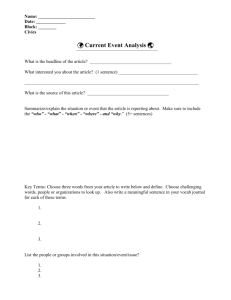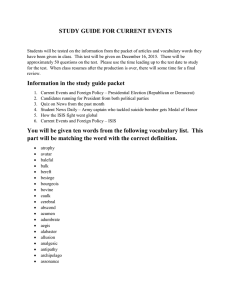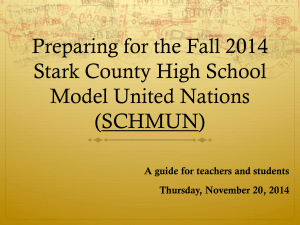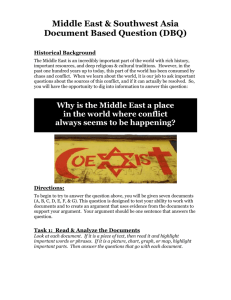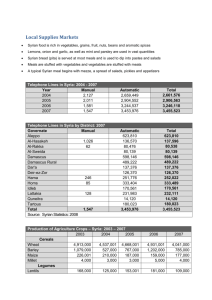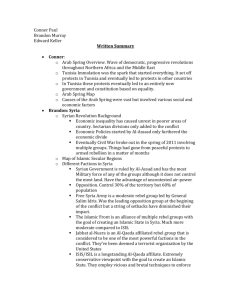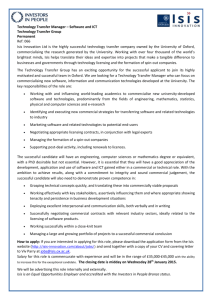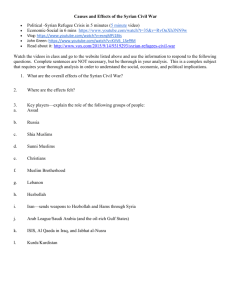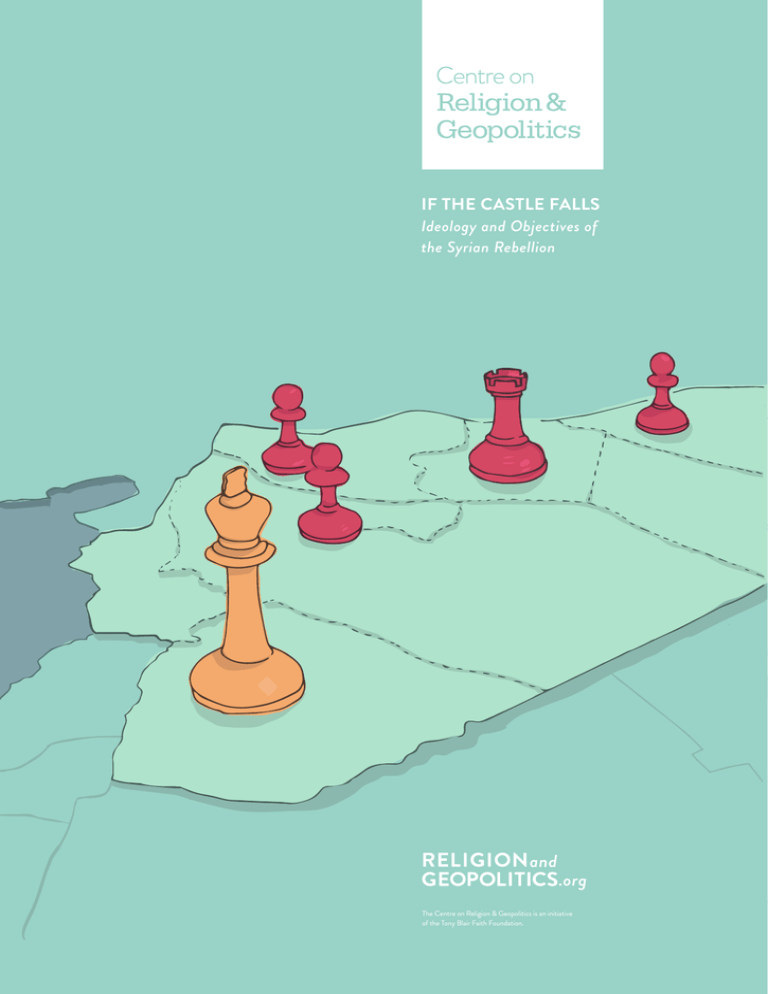
IF THE CASTLE FALLS
Ideology and Objectives of
the Syrian Rebellion
The Centre on Religion & Geopolitics is an initiative
of the Tony Blair Faith Foundation.
1
Copyright © December 2015 by the Tony Blair Faith Foundation.
All rights reserved. Citation, reproduction and or translation of this publication, in whole or in part, for educational or other non-commercial purposes is authorised provided the source is fully acknowledged.
The Centre on Religion & Geopolitics is part of the The Tony Blair Faith Foundation which is registered with the Charity Commission of England and Wales with the number 1123243. We are a company
limited by guarantee and registered in England and Wales with company number 06198959. Our registered office is 66 Lincoln’s Inn Fields, London, WC2A 3LH. The Tony Blair Faith Foundation US has been
determined by the IRS to be a publicly-supported 501 (c) 3 organisation which can receive tax-deductible contributions from US donors. As an independent US tax-exempt organisation, TBFF US shares the
goals of, and provides support to, the Tony Blair Faith Foundation based in London.
2
Executive
Summary
WAITING IN THE WINGS: THE SYRIAN
JIHADIS READY TO TAKE OVER FROM ISIS
New research from the Centre on Religion & Geopolitics
(CRG) shows that five years on from the secular rising in
the Middle East commonly known as the “Arab Spring,”
Syria now hosts the largest gathering of jihadi groups in
modern times.
KEY FINDINGS
The current focus on a military defeat of ISIS does not
consider the other groups in Syria (and around the world)
with exactly the same global ideology and ambition.
UNLESS ASSAD GOES, THE SYRIAN
WAR WILL GO ON AND SPREAD FURTHER
SIXTY PER CENT OF MAJOR
SYRIAN REBEL GROUPS ARE ISLAMIST
EXTREMISTS
1.0
2.0
SYRIA’S REBELS CANNOT BE DIVIDED
INTO RADICALS AND MODERATES
3.0
Our research has found 15 groups stand ready to succeed
ISIS. Their ideology is Salafi-jihadism: A transnational
religious-political ideology based on a belief in violent jihad
to enforce a return to a perceived Islam of the Prophet
Mohammad’s first followers.
THE WORLD’S INACTION DRIVES THE
GROWTH OF EXTREMISM
4.0
IF WE DEFEAT ISIS, 15 GROUPS WAIT IN
THE WINGS
5.0
Its cruel and horrific acts rightly shock us. But it is not
simply a ‘death cult.’ ISIS represents a continuation of a
way of thinking that started before it existed and will carry
on if it is defeated. The West risks making a strategic failure
by focusing only on ISIS. Defeating it militarily will not end
global jihadism. We cannot bomb an ideology, but our war
is ideological.
If only ISIS is defeated, there is a high risk that dispersed
ISIS fighters and other Salafi-jihadi groups will expand their
horizons and launch attacks outside of Syria. “The West
destroyed the caliphate” will be a new rallying cry. In a dangerous escalation, these groups could aim to compete for
the spotlight – to ensure allegiance from the global fighters
and financing that ISIS currently attracts.
Two years after being deported from the UK, the thinking
of Abu Qatada, a leading ideologue of al-Qaeda, has featured prominently in its Syrian affiliate’s English language
magazine al-Risalah.
This briefing sets out who these groups are; their ideology,
numbers and alliances. Over several months our team has
tracked and analysed a range of sources to come up with
what we consider to be the most detailed analysis available
of the major jihadis and rebel groups operating in Syria.
3
SIXTY PER CENT OF MAJOR
SYRIAN REBEL GROUPS ARE ISLAMIST
EXTREMISTS
1.0
Our study of 48 rebel factions in Syria revealed that 33 per
cent of the groups – nearly 100,000 fighters – follow the
same ideology as ISIS. If you also take into account Islamist
groups (those who want a state governed by their interpretation of Islamic law), this figure jumps to 60 per cent.
Such alliances frequently change according to short-term
objectives and external events. For instance, the flare-up in
violence between Turkey and Kurdish separatists the PKK
has affected YPG operations in Syria.
These Islamist groups include organisations like the Imam
Bukhari Jamaat, an Uzbek transnational jihadi group that
pledged allegiance in 2014 to former Taliban leader Mullah
Omar.
JAISH AL-ISLAM
Meanwhile, unlike Salafi-jihadis or Islamists, only 23 per
cent of the militant groups in our sample had an ambiguous
or undefined ideology. These groups – often affiliated to
the Free Syrian Army – are defined largely by objectives,
not ideology. However, many are willing to fight with
extremists, and would probably accept an Islamist political
settlement to the civil war.
•
GROUP PROFILE
•
•
•
•
The rest of the groups we studied were Kurdish nationalists,
or ethnic, religious and tribal protection groups following
varied or ambiguous ideologies. Smaller protection groups
often ally themselves to larger, more powerful neighbours.
For example, the Syriac Military Council, a protection
force for Assyrian Christians in eastern Syria, falls under
the command of the Kurdish nationalist People’s Defence
Forces (YPG), while holding on to its separate identity.
rouping of Salafi factions operating around DamasG
cus, and the largest rebel group in the area.1
Controls al-Ghouta, near Damascus, which was subject to regime chemical weapon strikes in 2013.2
Has described Jabhat al-Nusra as “our brothers,”
saying “we don’t consider them Khawarij [heretics] as
is propagated against us, we fight alongside them and
they fight alongside us.”3
Has allegedly used civilians in cages as human shields
to deter Syrian and Russian airstrikes.4
In July 2015 released a brutal video purporting to ‘turn
[ISIS’] tactics against them,’ by wearing the orange
jumpsuits usually seen on ISIS’ victims while executing
up to 18 members of the group.5
FIGURE 1.1
Groups by Ideology
By percentage of rebel groups studied
100
90
80
70
60
50
40
33%
27%
30
1 http://english.alarabiya.net/en/News/middle-east/2015/05/03/Syria-army-tightens-siege-of-rebel-bastion-near-Damascus-monitor.html
23%
20
6%
2 http://www.thedailybeast.com/articles/2015/12/15/the-rebel-commander-of-damascus.html
10%
3 https://www.youtube.com/watch?v=Zajo2GeKyV4
4 http://www.longwarjournal.org/archives/2015/11/syrian-rebels-use-caged-civilians-fighters-to-deter-airstrikes.php
10
0
Salafi-Jihadi
Islamist
Ambiguous
Kurdish
Nationalist
5 http://www.independent.co.uk/news/world/middle-east/isis-rivalsjaysh-al-islam-turn-militant-groups-tactics-against-them-in-mass-execution-video-10357957.html
Protection
Groups
4
DIVISION OF GROUPS BY IDEOLOGY
SALAFI-JIHADI
ISLAMIST
Ahrar al-Sham
19th Division
Ajnad Kawkaz
Asala walTanmiya
Ajnad Sham
Islamic Union
Ansar al-Sham
Fastaqim
Kama Umirta
Harakat Nour
al-Din al-Zenki
ISIS
Jabhat alNusra
Jaish al-Islam
Jaish al-Jihad
Jund al-Aqsa
Khorasan
Group
Kurdish Islamic
Front
Liwa al-Haqq
Liwa al-Umma
Durou alThawra
Faylaq alRahman
AMBIGUOUS
Jabhat
al-Akrad
Al-Sanadid
Forces
Dawn of
Freedom
Brigades
YPG
Al-Shaitat
YPJ
Seljuk Brigade
Division 13
Fursan alHaqq
Jaish al-Nasr
Imam Bukhari
Jamaat
Liwa Thuwwar
al-Raqqa
Jaish al-Sunna
Martyrs of
Syria Brigades
Liwa Muhajirin
wal-Ansar
Martyrs of
Islam Brigade
PROTECTION GROUPS*
18th March
Division
First Coastal
Division
Liwa al-Tawhid
KURDISH NATIONALIST
New Syria
Forces
Northern
Storm Brigade
Sham Legion
Northern Sun
Battalion
Tajjamu alEzza
Revolutionary
Army
Yarmouk
Army
Turkestan
Islamic Party
TABLE 1.1 Division of groups by ideology (excludes coalitions)
5
Syriac Military
Council
Syrian
Turkmen
Brigades
* Represents tribal,
ethnic and religious
protection groups and
militias.
UNLESS ASSAD GOES, THE SYRIAN
WAR WILL GO ON AND SPREAD FURTHER
2.0
An assessment of the multiple – sometimes clashing – objectives of the groups we studied points to one overwhelming ambition: defeating President Bashar al-Assad’s regime.
A full 90 per cent of the groups hold the ousting of Assad
as a major goal. This finding makes it clear there can be no
peace deal that keeps Assad in power.
to a literalist reading of scripture. Islamists want a dominant
role for an interpretation of Islamic law in legal, economic
and political spheres. Other groups simply wish to follow
the lead of many Muslim majority legal systems, in which
‘sharia’ is the guiding principle of legislation.
Our sample was split when it came to two objectives:
establishing an Islamic state (often transnational), supported by 33 per cent; and establishing democracy in Syria,
supported by 38 per cent. There was no overlap between
the two objectives. Most of the groups that support an Islamic state are Salafi-jihadi, while the majority that support
democracy are ideologically ambiguous. There are some
Islamist groups supporting each objective.
Syria’s civil war began with the aim of removing Assad.
Groups from every ideology in our sample stated that
defeating him was an objective. So long as the West focuses
more on ISIS than addressing the driving force of the
conflict that the group exploits, extremists will continue
to use his rule as a recruiting pitch. Less extremist groups,
meanwhile, will seek help in achieving their aims wherever it
can be found.
Defeating ISIS was a goal shared by 38 per cent of our
sample. This ranged from Salafi-jihadi groups looking to
usurp ISIS, to tribal, religious and ethnic protection groups
representing communities under threat from the self-proclaimed caliphate.
The second most dominant objective in our sample was the
establishment of some form of Islamic law. Again, a wide
range of the groups we studied shared this goal, including
Salafi-jihadi, Islamist and ideologically ambiguous factions.
Their views on applying Islamic law were by no means
unified, however. Salafi-jihadi groups seek to implement a
single interpretation of Islamic law on the state, according
FIGURE 2.1
Groups by Objective
By percentage of rebel groups studied (objectives overlap and do not add up to 100 per cent)
100
90%
90
68%
80
70
60
38%
50
38%
33%
40
21%
30
10%
20
4%
10
0
Defeating
Assad
Defeating
ISIS
Transnational
Jihad
Islamic
State
Islamic
Law
6
Democracy
Ethnic/Religious
Protection
Independent
State
Group
Objective
SALAFI-JIHADI
Ahrar al-Sham
Ajnad Kawkaz
Ajnad Sham Islamic Union
Ansar al-Sham
Fastaqim Kama Umirta
Harakat Nour al-Din al-Zenki
ISIS
Jabhat al-Nusra
Jaish al-Islam
Jaish al-Jihad
Jund al-Aqsa
Khorasan Group
Kurdish Islamic Front
Liwa al-Haqq
Liwa al-Umma
Turkestan Islamic Party
Defeating Assad
Defeating ISIS
Transnational Jihad
ISLAMIST
19th Division
Asala wal-Tanmiya
Durou al-Thawra
Faylaq al-Rahman
First Coastal Division
Imam Bukhari Jamaat
Jaish al-Sunna
Liwa al-Tawhid
Liwa Muhajirin wal-Ansar
Martyrs of Islam Brigade
Northern Storm Brigade
Sham Legion
Tajjamu al-Ezza
Islamic State
Islamic Law
AMBIGUOUS
18th March Division
Dawn of Freedom Brigades
Division 13
Fursan al-Haqq
Jaish al-Nasr
Liwa Thuwwar al-Raqqa
Martyrs of Syria Brigades
New Syria Forces
Northern Sun Battalion
Revolutionary Army
Yarmouk Army
Democracy
Ethnic/Religious Protection
KURDISH NATIONALIST
Jabhat al-Akrad
YPG
YPJ
PROTECTION GROUPS
Al-Sanadid Forces
Al-Shaitat
Seljuk Brigade
Syriac Military Council
Syrian Turkmen Brigades
Independent State
FIGURE 2.2 Overlapping Group Objectives
7
SYRIA’S REBELS CANNOT BE DIVIDED
INTO RADICALS AND MODERATES
3.0
Where short- or long-term objectives overlap, groups form
coalitions regardless of ideology. Across the country, Islamists and non-Islamists battle Assad and ISIS together. The
dominant coalition in the south-west is the 30,000-fighter-strong Southern Front. Jaish al-Fatah, an al-Qaeda
led coalition that seeks to create an Islamic state, rallies
Islamists, Salafi-jihadis and ambiguous groups. And Syrian
nationalists and Kurdish separatists fight ISIS together in
the Syrian Democratic Forces coalition in the east. Groups
also tend to be spread out all over Syria; some fighting each
other in one part of the country while other members are
in coalition elsewhere.
This shows that any attempt by international powers to
distinguish between acceptable ‘moderates’ and unacceptable ‘extremists’ is flawed. Such overlaps are endless. In
one battle in Jisr al-Shughour this year, Jabhat al-Nusra
fighters were used as shock troops, with fire support from
Western-armed rebels.6 Meanwhile, a Free Syrian Army
group vetted and supplied with arms by the United States
is reported as having lied about its collaboration with Jabhat
al-Nusra.7
Group
Fighters
Fastaqim Kama Umirta
1,000
Asala wal-Tanmiya
5,000
Harakat Nour al-Din al-Zenki
1,500
Faylaq al-Rahman
2,000
Sham Legion
4,000
Ajnad Sham Islamic Union
3,000
TABLE 3.1
Source: Spectator
GROUP PROFILE
KHORASAN GROUP
•
•
Western attempts to divide the rebellion into moderates
and radicals have frequently encountered problems. Four
groups reported to have been vetted and supplied with US
anti-tank missiles8 are ideologically Islamist or Salafi-jihadi: Liwa Muhajirin wal-Ansar, Faylaq al-Rahman, Harakat
Nour al-Din al-Zenki and the First Coastal Division. The
claim that there are 70,000 moderate fighters ready to
support international airstrikes against ISIS is highly questionable. A recent study9 of the probable factions included
in this figure included 19,000 militants that we classify as
Islamist or Salafi-jihadi (see Table 3.1).
•
•
•
mall cell of veteran al-Qaeda members operating in
S
Syria. Ambiguous relationship with Jabhat al-Nusra,
most likely a ‘state within a state.’
Little is known about the group, although al-Qaeda
propaganda has referred to ‘Jaish Nusra,’ a small cell
within Jabhat al-Nusra serving in a ‘special operations’
role.
Named the ‘Khorasan group’ by US intelligence, after
a historic region in south and central Asia, because
of the prevalence of fighters from Afghanistan and
Pakistan in the group.10
Targeted by US airstrikes from September 2014 to
disrupt an “imminent attack” on western targets, after
Director of National Intelligence James Clapper said
that the group “may pose as much of a danger” as
ISIS.11
A Saudi national, Sanafi al-Nasr, described by US
Secretary of Defence Ash Carter as the leader of the
‘Khorasan Group,’ was killed in an airstrike in Aleppo
province in October 2015.12
6 http://tonyblairfaithfoundation.org/religion-geopolitics/commentaries/
opinion/jabhat-al-nusra-moves-towards-mainstream
7 ttp://europe.newsweek.com/moderate-rebels-please-raise-your-hands283449?rm=eu
10 https://www.washingtonpost.com/news/worldviews/wp/2014/09/25/
the-strange-story-behind-the-khorasan-groups-name/
8 https://hasanmustafas.wordpress.com/2015/05/08/the-moderaterebels-a-complete-and-growing-list-of-vetted-groups-fielding-towmissiles/
11 http://time.com/3421701/khorasan-al-qaeda-iraq-isis-syria/
12 http://www.longwarjournal.org/archives/2015/10/us-military-confirms-it-killed-senior-al-qaeda-strategist-sanafi-al-nasr-in-airstrike-insyria.php
9 http://blogs.new.spectator.co.uk/2015/11/yes-there-are-70000-moderate-opposition-fighters-in-syria-heres-what-we-know-about-them/
8
Group
Coalition
Objectives
SALAFI-JIHADI
Ahrar al-Sham
Ajnad Kawkaz
Ajnad Sham Islamic Union
Ansar al-Sham
Fastaqim Kama Umirta
Harakat Nour al-Din al-Zenki
ISIS
Jabhat al-Nusra
Jaish al-Islam
Jaish al-Jihad
Jund al-Aqsa
Khorasan Group
Kurdish Islamic Front
Liwa al-Haqq
Liwa al-Umma
Turkestan Islamic Party
ISLAMIST
19th Division
Asala wal-Tanmiya
Durou al-Thawra
Faylaq al-Rahman
First Coastal Division
Imam Bukhari Jamaat
Jaish al-Sunna
Liwa al-Tawhid
Liwa Muhajirin wal-Ansar
Martyrs of Islam Brigade
Northern Storm Brigade
Sham Legion
Tajjamu al-Ezza
AMBIGUOUS
18th March Division
Dawn of Freedom Brigades
Division 13
Fursan al-Haqq
Jaish al-Nasr
Liwa Thuwwar al-Raqqa
Martyrs of Syria Brigades
New Syria Forces
Northern Sun Battalion
Revolutionary Army
Yarmouk Army
KURDISH NATIONALIST
Jabhat al-Akrad
YPG
YPJ
Jaish al-Fatah
(March 2015)
Defeating Assad
Defeating ISIS
Islamic State
Syrian Democratic
Forces
(October 2015)
Defeating ISIS
Democracy
Mujahideen
Shura
Council
(May 2014)
Defeating ISIS
Mujahideen Army
(Jan 2014)
Defeating Assad
Defeating ISIS
Southern Front
(Feb 2014)
Defeating Assad
Defeating ISIS
Democracy
Pluralism
Syrian
Revolutionary
Command Council
(August 2015)
Defeating Assad
Euphrates Volcano
(September 2014)
Defeating ISIS
Islamic Front
(Nov 2013)
Defeating Assad
Islamic State
PROTECTION GROUPS
Al-Sanadid Forces
Al-Shaitat
Seljuk Brigade
Syriac Military Council
Syrian Turkmen Brigades
FIGURE 3.1 Overlapping Ideologies in Rebel Coalitions
9
THE WORLD’S INACTION DRIVES THE
GROWTH OF EXTREMISM
4.0
But perhaps one of the most interesting developments
followed the Assad regime killed hundreds in a chemical
weapons attack in August 2013. With no international
intervention after the attack in Ghouta, six coalitions still
active in the conflict today were established within just
over a year. This indicates that, in lieu of significant global
support, the rebel groups consolidated to strengthen their
hands against the regime.
The 48 groups in our study are all still active in the Syrian
conflict, though their founding dates range from the start
of the rebellion in 2011 to autumn this year. Most of the
active Salafi-jihadi groups were formed in 2011 and 2012;
many of their leaders were released from prison in a general
amnesty in 2011.
The rise of jihad in the Syrian civil war is an interesting
contrast with Libya, where international action put a stop
to the rebellion, but the failure to stabilize the country left
a vacuum for extremist groups to grow. In Syria, extremist
groups were prominent in the civil war from the beginning.
The fall of Libya’s Colonel Muammar Gaddafi in November 2011 was followed by a growth in rebel groups in Syria,
encouraged by signs that the rebellion could succeed.
Meanwhile, the rapid rise in the number of Salafi-jihadi
groups indicates that, as the war went on, factionalism (often driven by a drive for ideological purity) caused groups
to divide and multiply.
Factionalism slowed when ISIS entered the fray in Syria in
April 2013. In the face of its subsequent seizure of territory
from other groups, including ideological peers such as Jabhat al-Nusra and Ahrar al-Sham, rival forces consolidated,
forming the Salafi-jihadi Islamic Front coalition.
Coalition
Formation Date
Islamic Front
November 2013
Mujahideen Army
January 2014
Southern Front
February 2014
Mujahideen Shura Council
May 2014
Syrian Revolutionary Command
Council
August 2014
Euphrates Volcano
September 2014
TABLE 4.1
FIGURE 4.1
Formation of Groups and Coalitions
Groups and coalitions formed since start of Syria conflict, by ideology (excluding Ajnad Kawkaz and Turkestan Islamic Party)
Regime releases jihadis
and others held at
Sednaya prison
Syrian National
Coalition
forms
Protests against Colonel Gaddafi
regime begin in defeated in Libya
with NATO support
Deraa
Regime kills hundreds
in chemical weapons
attack
New Salafi-jihadi
coalition conquers
Idlib
ISIS enters
Syria
Airstrikes commence
on ISIS in Iraq and
Syria
7
6
5
4
3
2
1
0
Q1
Q2
Q3
Q4
2011
Salafi-Jihadi
Q1
Q2
Q3
Q4
2012
Islamist
Ambiguous
Q1
Q2
Q3
Q4
2013
Kurdish Nationalist
10
Q1
Q2
Q3
Q4
2014
Protection Group
Q1
Q2
Q3
Q4
2015
Coalition
Meanwhile, the longer the war continues without comprehensive international action to support rebels’ dominant
goal – defeating Assad – the greater the danger of more
of Syria falling to groups that share ISIS’ ideology. We can
already see this in the fall of the city of Idlib to the Jaish
al-Fatah coalition in March 2015. This coalition is dominated by Salafi-jihadis determined to create an Islamic state.
Idlib was the second provincial capital to fall entirely to
rebel groups after ISIS captured Raqqa.
2011
Q2
Q2
Q3
Q4
Q4
Q4
2012
Q1
Q1
GROUP PROFILE
AHRAR AL-SHAM
•
•
•
•
•
•
Q2
ectarian, linked to atrocities against Alawis and Shia.
S
An internationalist group, with stated aims to ‘destroy
with our hands Sykes-Picot’s walls.’13
Its statement of aims includes the complete “overthrow [of] the Assad regime in Syria and build[ing] an
Islamic state whose only sovereign, reference, ruler,
direction, and individual, societal and nationwide unifier is Allah Almighty’s Sharia (law).”14
Foreign fighters among its members, including from
the West.15
Close ties to al-Qaeda, with previous senior members
(including Abu Khaled al-Suri, a veteran jihadi killed by
ISIS in 2014) having been very close to the al-Qaeda
leadership.
The group has executed those who violate its interpretation of Islamic law in the territory it controls, and
beheaded captured opponents.
Q2
Q3
Q3
Q3
Q3
Q3
Q3
Q4
Q4
Q4
2013
Q1
Q2
Q2
Q2
Q2
Q2
GROUP PROFILE
Q3
JABHAT AL-NUSRA
•
•
•
•
•
Q4
l-Qaeda’s affiliate in Syria, reaffirming in December its
A
commitment to the group’s leader Ayman al-Zawahiri.16
Has successfully embedded itself into broad coalitions
fighting Assad, alongside factions including the FSA in
the battle for Idlib city.
Destroyed the US-trained anti-ISIS group ‘Division
30’ immediately after it re-entered Syria, showing off
captured US weaponry.17
Thought to have the second-largest number of foreign
fighters in Syria.
In August 2015, Jabhat al-Nusra chief spokesman Abu
Firas al-Suri said “our goals are not limited to Syria,
but our current battle is.”18
Q4
Q4
2014
Q1
Q1
Q1
Q1
Q2
Q2
Q2
Q2
Q3
Q3
2015
13 http://www.middleeasteye.net/columns/ahrar-al-sham-s-apocalyptic-vision-syria-and-beyond-455405201
Q1
Q1
14 http://studies.aljazeera.net/en/reports/2014/09/20149147499306405.htm#a2
Q1
15 http://soufangroup.com/wp-content/uploads/2014/06/TSG-ForeignFighters-in-Syria.pdf
Q2
16 http://www.longwarjournal.org/archives/2015/12/al-nusrah-frontleader-refuses-to-break-with-al-qaeda.php
Q3
Q2
Q3
17 http://www.telegraph.co.uk/news/worldnews/middleeast/syria/11882195/US-trained-Division-30-rebels-betrayed-US-and-handweapons-over-to-al-Qaedas-affiliate-in-Syria.html
YPG
Northern Storm Brigade
Jaish al-Islam
Ahrar al-Sham
Martyrs of Syria Brigades
Harakat Nour al-Din al-Zenki
Jabhat al-Nusra
YPJ
Liwa Muhajirin wal-Ansar
Liwa al-Umma
Khorasan Group
Durou al-Thawra
Liwa al-Tawhid
Ansar al-Sham
Liwa al-Haqq
Liwa Thuwwar al-Raqqa
Martyrs of Islam Brigade
Asala wal-Tanmiya
Fastaqim Kama Umirta
Syriac Military Council
19th Division
ISIS
18th March Division
Imam Bukhari Jamaat
Division 13
Kurdish Islamic Front
Faylaq al-Rahman
Ajnad Sham Islamic Union
Islamic Front
Sham Legion
Jund al-Aqsa
Mujahideen Army
Southern Front
Dawn of Freedom Brigades
Northern Sun Battalion
Jabhat al-Akrad
Mujahideen Shura Council
Syrian Revolutionary Command Council
Euphrates Volcano
Jaish al-Sunna
Jaish al-Jihad
Jaish al-Fatah
Revolutionary Army
New Syria Forces
Jaish al-Nasr
Syrian Democratic Forces
TABLE 4.2 Groups and coalitions formed since start of Syria
conflict, by ideology (excluding Ajnad Kawkaz and Turkestan
Islamic Party)
18 https://www.ctc.usma.edu/posts/al-qaida-plays-a-long-game-in-syria
11
IF WE DEFEAT ISIS, 15 GROUPS WAIT IN
THE WINGS
5.0
The 16 Salafi-jihadi groups fighting in the Syrian civil war
have some 96,000 fighters in their ranks. According to
the latest CIA estimate, ISIS accounts for only 31,000 of
these. 19
These eight transnational Salafi-jihadi groups alone account
for over 30,000 militants, including foreign fighters (see
Table 5.1).
Jabhat al-Nusra’s leader, Abu Mohammad al-Jolani, has
claimed that 30 per cent of his force is made up of foreign
fighters.21 If these militants reflect the proportions of foreign fighters in the wider conflict,22 this would indicate over
70 British citizens fighting for the group.
Recent research from the CRG revealed the shared ideology of Salafi-jihadi groups.20 ISIS is no more extreme than
al-Qaeda, Ahrar al-Sham or any other group that shares
its ideology. Their short-term objectives may differ, but
ultimately all such groups pose a threat to the West if they
operate unchallenged.
Group
Fighters
Ahrar al-Sham
15,000
Ajnad Kawkaz
50
Ajnad Sham Islamic Union
3,000
Jabhat al-Nusra
10,000
Jaish al-Jihad
400
In our study alone, there are 15 Salafi-jihadi groups, many
opposed to ISIS, which share the group’s vicious ideology
and will benefit from its defeat. Of these, eight have explicitly committed themselves to international jihad, making
them highly likely to support attacks on the West.
Jund al-Aqsa
1,000
Turkestan Islamic Party
1,000
Khorasan Group
50
FIGURE 5.1
TABLE 5.1
If ISIS is defeated, there are at least 65,000 fighters
belonging to other Salafi-jihadi groups ready to take its
place. Of these groups, four are large enough to hold
territory and build their utopian Islamic state: Ahrar al-Sham (15,000), Jabhat al-Nusra (10,000), Jaish al-Islam
(17,000), and Liwa al-Umma (6,000). That’s a total of
48,000 militants, who have also shown willingness to join
forces in coalitions.
Fighters for Salafi-Jihadi Groups
Strength on Salafi-jihadi groups in Syria, by number of fighters
35,000
32%
30,000
25,000
20,000
15,000
10,000
19 http://www.bbc.co.uk/news/world-middle-east-29169914
Turkestan Islamic Party
Liwa al-Umma
Liwa al-Haqq
Kurdish Islamic Front
Khorasan Group
Jund al-Aqsa
Jaish al-Jihad
Jaish al-Islam
Jabhat al-Nusra
ISIS
Harakat Nour al-Din al-Zenki
Fastaqim Kama Umirta
Ansar al-Sham
Ajnad Sham Islamic Union
Ajnad Kawkaz
0
Ahrar al-Sham
5000
21 http://www.aljazeera.com/news/2015/06/nusra-leader-conflict-isil-syria-150604021024858.html%3E
20 ‘Inside the Jihadi Mind: Understanding Ideology and Propaganda’,
October 2015. http://tonyblairfaithfoundation.org/religion-geopolitics/
reports-analysis/report/inside-jihadi-mind
22 http://soufangroup.com/wp-content/uploads/2015/12/TSG_ForeignFightersUpdate4.pdf
12
Conclusion
These figures – which represent just a selection of currently active groups in the Syrian conflict – demonstrate the
importance of a holistic approach to the conflict. The vast
majority of militant groups in the civil war, regardless of
their ideological affiliations, wish to depose Assad. Unless
Assad goes, any peace deal will fail.
However, without regional support to pacify the country,
the defeat of Assad alone will not end the conflict either,
and will leave it vulnerable to domination by extremist
forces. International attempts to divide the rebellion into
moderates and extremists are bound to fail, because the
rebels themselves rarely make the same distinction. While
some groups apply tests of ideological purity to their allies,
others are more pragmatic, and will work with whatever
group supports their objectives. With the dominance of
Islamist and Salafi-jihadi groups in the conflict, this makes
it highly likely that any ultimate settlement of the conflict
will have an Islamist hue.
However, the greatest danger to the international community are the groups that share the ideology of ISIS, but
are being ignored in the battle to defeat the group. While
military efforts against ISIS are necessary, policy makers
must recognise that its defeat will not end the threat of
Salafi-jihadism unless it is accompanied by an intellectual
and theological defeat of the pernicious ideology that
drives it.
13
GLOSSARY
METHODOLOGY
SALAFI-JIHADISM: A transnational
The data in this briefing represents
a cross-section of 48 groups from
across the Syrian rebellion. The
CRG’s analysts drew these groups
from a sample of 90 that are active
in the Syrian civil war, including
pro-regime forces. The 90 groups
in our full sample do not represent
a comprehensive analysis of every
group active in the conflict. The
groups were chosen on the basis of
their significance (in terms of media
and government interest) or size.
religious-political ideology based on
a literalist reading of scripture and
a belief in violent jihad to enforce a
return to the perceived Islam of the
Prophet Mohammad’s first followers.
ISLAMISM: A modern religious-po-
litical ideology requiring a dominant
role for an interpretation of Islam as
state law.
AMBIGUOUS: Rebel groups without
any clearly stated ideological goals.
PROTECTION GROUPS: Tribal,
ethnic, and religious groups primarily
focused on protecting their respective communities.
KURDISH NATIONALIST: Groups
emphasising Kurdish national identity
based on shared ethnic or cultural
attributes.
Our assessment of the ideology and
objectives of each was calculated on
the basis of its official statements,
reported statements of its senior
membership, public government and
intelligence assessments, and opensource reports.
Membership figures for groups
were calculated where possible on
the most recent publicly available
intelligence assessment. Where this
was not available, our analysts drew
a reasonable estimate from public
reports and statements by group
members.
14
ABOUT the CENTRE ON
RELIGION & GEOPOLITICS
Across the world, the interaction
of religion and conflict is making its
impact felt. Political ideologies and
events are exposed to the pressures
of religion. Policy makers can no
longer ignore the threat posed by
violent religious ideologies, but if they
are to be defeated, they must be
understood.
Through evidence-based reports,
media commentary, high-level events
and policy briefings, the Centre
on Religion & Geopolitics (CRG)
provides that nuanced understanding.
We present informed analysis on the
interaction of religion and conflict
globally, offering policy options to
meet the scale of the challenge.
15
16

